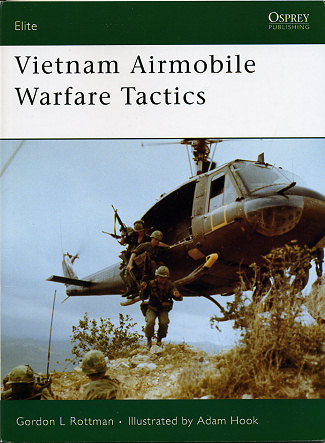 This
latest book in the Osprey 'Elite' series deals with Airmobile Tactics
during Vietnam. Though vertical envelopment was used on a very small scale
during the French war in Vietnam and again in Algeria, the greatest use of the
helicopter in those conflicts was much the same that was practiced in Korea;
medical evacuation or medevac. Helicopter armament was also pretty well limited
to what the crew could carry in terms of hand held weapons.
This
latest book in the Osprey 'Elite' series deals with Airmobile Tactics
during Vietnam. Though vertical envelopment was used on a very small scale
during the French war in Vietnam and again in Algeria, the greatest use of the
helicopter in those conflicts was much the same that was practiced in Korea;
medical evacuation or medevac. Helicopter armament was also pretty well limited
to what the crew could carry in terms of hand held weapons.
Much of the Army's interest in using helicopters in direct
combat came from the results of US Marine use during Korea in 1951 where they
were used in a limited way for all the various missions that would later be used
in Vietnam, aside from the use of armed gunships. Slowly the various services
started building up forces. This growth was held back as much by suitable
helicopters as anything else, but by 1960, the Army had the H-21 and the Marines
the H-34, both capable of carrying a sufficient number of troops to make air
assault a worthwhile endeavor. In early 1962, the first large scale assault
operations were held when the Army transported ARVN (Army of Vietnam) troops
into battle. This was followed by experimental use of attack helicopters around
the same time.
It was realized that the H-21 was too large and too slow to
be an effective assault helo, though it could carry a goodly payload. What
really moved things along was the development of the UH-1 or Huey. This was a
relatively fast helicopter and while smaller than the H-21 and without its load
carrying abilities, was easy to build and equally easy to maintain. Other types
of helicopter were developed for heavy lift, light observation, and other tasks,
but it was the Huey that was the mainstay of the Army's aviation assets in
Vietnam. This basic airframe was also developed into heavily armed attack
helicopters and eventually led to the dedicated Cobra gunships.
Gordon Rottman was in country during the later years of the
war and so has an insight into operations that many writers would not have. He
has done a superlative job on this book, dividing it into several major
sections. He first concentrates on the helicopter itself discussing its
development and use, threats to the helo and armament carried by various types.
Then the development and testing of the theories of airmobility, which
eventually led to the first operations of the 1st Cavalry Division (Airmobile)
in the mid 1960s. That success spawned a number of other units in both the Army
and the Marine Corps to take advantage of what was learned. He then moves on to
describe the various missions that are used by airmobile units, for dropping off
and picking up troops are only the beginning. The book then covers that basics
of air assault from the initial deployment of the ground troops through keeping
them supplied and taking out wounded until the mission is over and all are
removed. This is then finished up by a discussion of the gunship and how it is
used.
All of this is enhanced by the super illustrations of Adam
Hook and an excellent selection of period photographs. This makes for a truly
outstanding book on the subject and should be required reading for all who are
interested in helicopter development or the Vietnam war.
May 2007
For more on the complete line of Osprey books,
visit www.ospreypublishing.com. In the US, it is
Osprey Direct at 44-02 23rd St, Suite 219, Long Island City, NY 11101., where you can
get a catalogue of available books.
If you would like your product reviewed fairly and quickly by a
site that has over 350,000 visitors a month, please contact
me or see other details in the Note to
Contributors.
 This
latest book in the Osprey 'Elite' series deals with Airmobile Tactics
during Vietnam. Though vertical envelopment was used on a very small scale
during the French war in Vietnam and again in Algeria, the greatest use of the
helicopter in those conflicts was much the same that was practiced in Korea;
medical evacuation or medevac. Helicopter armament was also pretty well limited
to what the crew could carry in terms of hand held weapons.
This
latest book in the Osprey 'Elite' series deals with Airmobile Tactics
during Vietnam. Though vertical envelopment was used on a very small scale
during the French war in Vietnam and again in Algeria, the greatest use of the
helicopter in those conflicts was much the same that was practiced in Korea;
medical evacuation or medevac. Helicopter armament was also pretty well limited
to what the crew could carry in terms of hand held weapons.